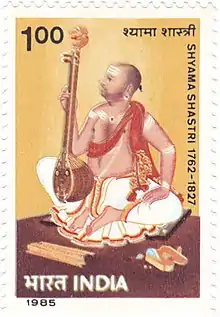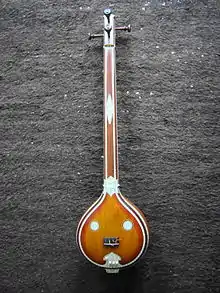Syama Sastri
Syama Sastri (Telugu : శ్యామ శాస్త్రి; IAST: Śyāma Śāstri; 26 April 1762 – 1827) or Shyama Shastri was a musician and composer of Carnatic music. He was the oldest among the Trinity of Carnatic music, Tyagaraja and Muthuswami Dikshitar being the other two.[2]
Syama Sastri | |
|---|---|
 | |
| Born | Venkata Subrahmanya 26 April 1762 |
| Died | 1827 (aged 64–65) |
| Other names | Syama Krishna |
| Occupation | Carnatic music composer |
| Carnatic music |
|---|
 |
| Concepts |
| Compositions |
| Instruments |
|
Early life and career
Syama Sastri, whose birth name was Venkata Subrahmanya, was born on 26 April 1762 in a Telugu Brahmin family.[3] He was also known as one of the trinity of carnatic music.[4][5] To later generations, he is better known by his adopted name Syama Sastri or by his musical mudra (signature) Syama Krishna.[6] He was born in Tiruvarur, in what is now the state of Tamil Nadu. He received his instruction in the vedas, astrology, and other traditional subjects early on and learned music from his maternal uncle. He was later trained in music by Adiappayya, a noted durbar musician of Thanjavur.[7]
Although Śyāma Śastri did not compose as many kritis as his two prolific contemporaries, his compositions are still well known due to the literary, melodic and rhythmic proficiency observed in them. It is said that he composed about three hundred pieces in all.[8]
He did not have many disciples to propagate his compositions, nor was the printing press widely accessible during his time. More importantly, the scholarly nature of his compositions made them more appealing to the learned than to the lay. Additionally, they feature a more formal form of Telugu which borrows heavily from Sanskrit. In contrast, Tyagaraja composes in generally more colloquial dialect of Telugu.
There are also a number of krithis in Tamil attributed to him. Most of his compositions propitiate the Goddess Kamakshi.[8]
He composed kritis, varṇa(s) and svarajati(s) with the ankita or mudra (signature) Śyāma Krishna. He was probably the first to compose in a new form of the svarajati musical genre, where the compositions could be rendered solely in a singing or instrumental manner. Prior to this, the svarajati was primarily a dance form, and was close in structure to the dance Varṇaṃ (padavarṇaṃ).[9]
His set of three famous svarajati(s) are intended to be sung in concert rather than danced, and are sometimes referred to as "Ratnatrayam" (Three jewels). They are Kāmākṣhī Anudinamu, Kāmākṣhī Padayugamē, and Rāvē himagiri kumāri, composed in the ragas Bhairavi, Yadukula kambhoji and Todi respectively. The former two are set to Miśra Cāpu Tāḷa, while the third is set to Ādi Tāḷa.
He is known for his ability to compose in the most complex of tāḷas.[10]
Legacy
Sastri had a number of disciples who excelled at the art. Alasur Krishna Iyer became a musician at the royal durbar in Mysore. Porambur Krishna Iyer popularised many of his guru's works. Another disciple, Talagambadi Panchanada Iyer also made his mark as a composer. Another disciple named Dasari gained fame as a noted nāgaswaram player.[7]
Compositions
The below sections mention some of his compositions.
Svara Jati
| Composition | Raga | Tāḷa | Language | Description |
|---|---|---|---|---|
| Kāmākṣhī anudinamu maruvakanē కామాక్షీ అనుదినము మరువకనే | Bhairavi | Miśra Cāpu | Telugu | |
| Kāmākṣhī nī padayugame sthiramaninē | Yadukulakamboji | Miśra Cāpu | Telugu | |
| Rāvē himagiri kumāri రావే హిమగిరి కుమారీ | Todi | Ādi | Telugu |
Kriti
| Composition | Raga | Tāḷa | Language | Description |
|---|---|---|---|---|
| Śaṅkari Śaṃkuru candra mukhī Sanskrit: शङ्करि शंकुरु चन्द्र मुखी Telugu Script: శఙ్కరి శంకురు చన్ద్ర ముఖీ | Sāvēri | Ādi – Tiśra Gati | Sanskrit | |
| pAlayAshu mAM paradEvatE | Arabhi | Sanskrit | ||
| kanaka śaila vihāriṇī Sanskrit: कनक शैल विहारिणी Telugu Script: కనక శైల విహారిణీ | Punnāga Varāḷi | Ādi | Sanskrit | |
| Birāna varālicci brōvave బిరాన వరాలిచ్చి బ్రోవవె | Kaḷyāṇi | Ādi – Tiśra Gati | Telugu | |
| Dēvī brōva samayamu దేవీ బ్రోవ సమయము | Cintāmaṇi | Telugu | ||
| kAmAkSi lOka sAkSiNi | madhyamAvati | Sanskrit | ||
| Himādri sutē pāhimāṃ హిమాద్రి సుతే పాహిమాం | Kaḷyāṇi | Ādi | Sanskrit | |
| Māyammā yani nē pilacite మాయమ్మా యని నే పిలచితె | Ahiri | Ādi | Telugu | |
| Mari vērē gati evvarammā మరి వేరే గతి ఎవరమ్మా | Anandabhairavi | Miśra Cāpu | Telugu | |
| Nannu brōvu lalitā నన్ను బ్రోవు లలితా | Lalita | Miśra Cāpu | Telugu | |
| O jagadambā nannu ఓ జగదమ్బా నన్ను | Anandabhairavi | Ādi | Telugu | |
| Pārvati ninu nē nera nammiti పార్వతీ నిను నే నెర నమ్మితి | kalkaḍa | Telugu | ||
| Sarōja daḷa nētri himagiri putrī సరోజ దళ నేత్రి హిమగిరి పుత్రీ | śaṃkarābharaṇaṃ | Ādi | Telugu | |
| Tallī ninnu nera namminānu vinavē తల్లీ నిన్ను నెర నమ్మినాను వినవే | Kaḷyāṇi | Miśra Cāpu | Telugu | |
| Pāhi Srī Girirājasutē Karuṇākalitē | Anandabhairavī | Rūpakaṃ | Telugu-Sanskrit | |
| Devī Mīna Nētrī Brōva | Shankarabharanam | Adi | Telugu | |
| Ennēramum un Nāmam என்னேரமும் உன் நாமம் | Pūrvikalyāni | Misra caapu | Tamil | |
| Kamakshi Bangaru కామాక్షి బంగారు | Varali | Misra caapu | Telugu | |
| Ennēramum un Pāda Kamalam என்னேரமும் உன் பாத கமலம் | Punnāgavarāḷi | Miśra Cāpu | Tamil |
See also
Notes
References
- "Thiruvaiyaru Thyagaraja Aradhana". Archived from the original on 14 January 2016. Retrieved 15 November 2015.
- P. Sambamoorthy (1962). Great Composers. Indian Music Publishing House. pp. 69–94.
- "SYAMA SASTRI (1762 - 1827 ) - PART 1". Archived from the original on 1 December 2021. Retrieved 2 October 2022.
- Rajagopalan, N. (1994). A Garland: A Biographical Dictionary of Carnatic Composers and Musicians. Bharatiya Vidya Bhavan. p. 264.
- Ramakrishna, Lalita (2003). Musical Heritage of India. Shubhi Publication. p. 176. ISBN 978-81-87226-61-1.
- "SMA Article: Shyama Shastri - A Blessed Composer".
- OEMI:SS.
- Foltinek, Herbert (2005). Imagination All Compact. How did Charles Dickens Compose His Novels?. doi:10.1553/0x0007eaf1. ISBN 978-3-7001-3528-9.
- V, Sriram (18 July 2019). "Songs in praise of Kanchi Varada". The Hindu. ISSN 0971-751X. Retrieved 19 January 2023.
- Madan Gopal (1990). K.S. Gautam (ed.). India through the ages. Publication Division, Ministry of Information and Broadcasting, Government of India. p. 231.
Sources
- "Śyāma Śāstri". The Oxford Encyclopaedia of the Music of India. Oxford University Press. 2011. ISBN 9780195650983. Retrieved 20 September 2018.
- Fuller, C. J.; Narasimhan, Haripriya (11 November 2014). Tamil Brahmans: The Making of a Middle-Class Caste. University of Chicago Press. ISBN 978-0-226-15288-2.